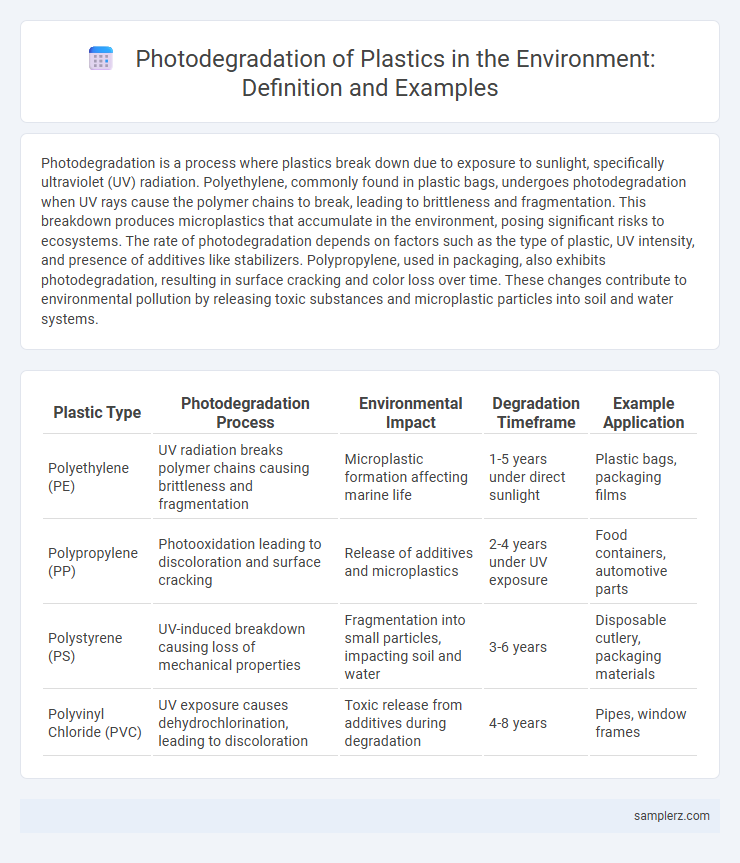Photodegradation is a process where plastics break down due to exposure to sunlight, specifically ultraviolet (UV) radiation. Polyethylene, commonly found in plastic bags, undergoes photodegradation when UV rays cause the polymer chains to break, leading to brittleness and fragmentation. This breakdown produces microplastics that accumulate in the environment, posing significant risks to ecosystems. The rate of photodegradation depends on factors such as the type of plastic, UV intensity, and presence of additives like stabilizers. Polypropylene, used in packaging, also exhibits photodegradation, resulting in surface cracking and color loss over time. These changes contribute to environmental pollution by releasing toxic substances and microplastic particles into soil and water systems.
Table of Comparison
| Plastic Type | Photodegradation Process | Environmental Impact | Degradation Timeframe | Example Application |
|---|---|---|---|---|
| Polyethylene (PE) | UV radiation breaks polymer chains causing brittleness and fragmentation | Microplastic formation affecting marine life | 1-5 years under direct sunlight | Plastic bags, packaging films |
| Polypropylene (PP) | Photooxidation leading to discoloration and surface cracking | Release of additives and microplastics | 2-4 years under UV exposure | Food containers, automotive parts |
| Polystyrene (PS) | UV-induced breakdown causing loss of mechanical properties | Fragmentation into small particles, impacting soil and water | 3-6 years | Disposable cutlery, packaging materials |
| Polyvinyl Chloride (PVC) | UV exposure causes dehydrochlorination, leading to discoloration | Toxic release from additives during degradation | 4-8 years | Pipes, window frames |
Introduction to Photodegradation in Plastics
Photodegradation in plastics involves the breakdown of polymer chains when exposed to ultraviolet (UV) radiation from sunlight, leading to material deterioration. Common plastics such as polyethylene (PE), polypropylene (PP), and polystyrene (PS) undergo photodegradation through chain scission and oxidative reactions triggered by UV light. This process results in changes to the plastic's physical properties, such as brittleness and color fading, contributing to environmental pollution through microplastic formation.
Common Plastics Susceptible to Photodegradation
Common plastics susceptible to photodegradation include polyethylene (PE), polypropylene (PP), and polystyrene (PS), which break down when exposed to ultraviolet (UV) light from the sun. Polyethylene, widely used in packaging and plastic bags, undergoes chain scission causing brittleness and fragmentation. Photodegradation of polypropylene, found in automotive parts and containers, results in discoloration and loss of mechanical integrity, accelerating plastic pollution.
Role of Sunlight in Photodegradation Processes
Sunlight initiates photodegradation in plastics by breaking chemical bonds within polymer chains through ultraviolet (UV) radiation exposure. This process results in the fragmentation of plastics into smaller particles, often leading to microplastic formation in the environment. UV-induced oxidative reactions accelerate the decomposition of polymers such as polyethylene and polypropylene, significantly impacting plastic durability and environmental persistence.
Polyethylene Photodegradation: Case Studies
Polyethylene photodegradation occurs when ultraviolet (UV) radiation breaks down the polymer chains, leading to surface cracking, discoloration, and loss of mechanical strength. Case studies reveal that environmental exposure accelerates this process, with factors like UV intensity, temperature, and oxygen availability significantly influencing degradation rates. Monitoring these changes helps in developing more sustainable plastics and improving waste management strategies.
Photodegradation of Polypropylene and Its Impact
Photodegradation of polypropylene occurs when ultraviolet (UV) radiation breaks the polymer chains, leading to surface cracking, discoloration, and reduced mechanical strength. This degradation process accelerates microplastic formation, contributing to environmental pollution in marine and terrestrial ecosystems. Understanding photodegradation mechanisms in polypropylene is crucial for developing UV-resistant additives and improving plastic waste management strategies.
Environmental Consequences of Plastic Photodegradation
Photodegradation of plastics releases microplastics and toxic chemicals into soil and water, disrupting ecosystems and harming wildlife. This process accelerates the fragmentation of plastic waste, increasing pollution levels in marine and terrestrial environments. Persistent pollutants from degraded plastics accumulate in the food chain, posing significant risks to human health and biodiversity.
Microplastic Formation Through Photodegradation
Photodegradation accelerates the breakdown of plastic waste into smaller fragments under exposure to sunlight, primarily ultraviolet (UV) radiation. This process facilitates the formation of microplastics, particles smaller than 5 millimeters, which pose significant environmental hazards by infiltrating aquatic ecosystems and food chains. Research indicates that common plastics like polyethylene and polypropylene degrade via photochemical reactions, releasing microplastics that persist and accumulate in marine environments.
Marine Plastic Waste and Photodegradation Examples
Photodegradation of marine plastic waste occurs when sunlight breaks down polymers like polyethylene and polypropylene found in plastic debris, causing fragmentation into microplastics. UV radiation accelerates this degradation process, impacting marine ecosystems by increasing the abundance of tiny plastic particles that are ingested by marine organisms. Common examples include plastic bags, fishing nets, and bottles degrading on coastlines and in oceans due to prolonged exposure to sunlight.
Photodegradation Accelerators in Plastic Waste Management
Photodegradation accelerators such as titanium dioxide and benzophenone additives enhance the breakdown of plastic waste by increasing the rate of polymer chain scission under UV radiation. These compounds boost oxidative and photo-oxidative reactions, facilitating faster degradation of polyethylene, polypropylene, and polystyrene materials in environmental conditions. Optimizing the concentration and distribution of photodegradation accelerators in plastic formulations advances sustainable plastic waste management by reducing persistence and microplastic formation in ecosystems.
Future Outlook: Mitigating Photodegradation Impacts
Emerging innovations in biodegradable additives and UV stabilizers show promise in mitigating photodegradation of plastics, reducing microplastic pollution and environmental toxicity. Research in advanced polymer composites aims to enhance plastic durability under solar radiation while maintaining recyclability and sustainability. Collaborative efforts between material scientists and environmental agencies focus on developing regulations and technologies to curb photodegradation's ecological footprint by promoting circular economy practices.

example of photodegradation in plastic Infographic
 samplerz.com
samplerz.com